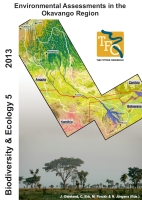
|

Department of Biology Institute of Plant Science and Microbiology |
| Division BEE > Biodiversity & Ecology > Vol.5 > Article 53 |
Biodiversity & Ecology
Journal of the Division Biodiversity, Evolution and Ecology of Plants , Institute for Plant Science and Microbiology, University of Hamburg.
Research Article Open Access Vegetation of the Okavango river valley in Kavango West, Namibia Keywords: Braun-Blanquet; desertification; floodplain vegetation; flooding regime; land degradation; land use; phytosociology; seasonal wetland vegetation
Título: A vegetação do vale do Rio Okavango no Kavango West, NamÃbia Palavras-chave: Braun-Blanquet; degradação do solo; desertificação; fitossociologia; regime de inundação; uso do solo; egetação sazonal de pantanos; vegetação de várzea Resumo: A vegetação do vale do Rio Okavango foi apenas descrita previamente em termos gerais ao longo da encosta, da base do vale até o topo do platô de areia, sem uma definição clara dos diferentes tipos de vegetação ou sua composição distinta. No entanto, o fundo do vale auxilia uma grande parte da população da região, que é dependente dos serviços ecosistemicos fornecidos pela vegetação. Uma pesquisa do tipo âBraun- Blanquetâ foi feita para descrever a vegetação do vale do Rio Okavango, na região oeste do Kavango na NamÃbia, com ênfase especial na vegetação de várzea. O estudo seguiu as diretrizes estabelecidas para o projeto "Estudo da Vegetação da NamÃbia". Os dados foram classificados usando o procedimento modificado TWINSPAN em Juice, resultando em quatro syntaxa de ordem superior e 11 associações de vegetação. Descrevemos essas associações informalmente de acordo com diagnóstico de espécies, riqueza das espécies e variações ambientais. No caso de associações de várzea e pantano, as informações sobre o regime de inundação (profundidade, duração e probabilidade de inundação) são fornecidas. Embora os grupos de ordem superior dentro dessa associação apareçam muito claramente, apenas os pantanos podem estar relacionados com syntaxa de ordem superior similar descrita nos pantanos Oshana, no delta Cuvelai. A colocação e validade dos outros três syntaxa de ordem superior não estão claras nesta fase e precisam ser tratadas em uma sinopse de todas as descrições de vegetação existentes, para a vasta ecoregião de Kalahari. As diversas associações de vegetação podem ser claramente associadas com posições distintas na paisagem. O grau de inundação em um extremo e a arenosidade do solo no outro extremo, definem o tipo e a composição da vegetação . A associação Acacia eriolobaâSchinziophyton rautanenii (7) foi removida e arada em pelo menos 90%, remanescendo apenas pequenos fragmentos dessa vegetação. A expansão dos campos nas areias da plataforma do aterro é preocupante, levando a temores de maior degradação do solo e, finalmente, a desertificação. Apesar de sinais de sobrepastoreio serem vÃsiveis dentro das várzeas, isto ainda não pode ser quantificado distintamente. O sobrepastoreio nos pantanos levará à destruição da desova e habitats de reprodução dos peixes, prejudicando a outra grande fonte de alimento dos povos da região.
Suggested citation: |
